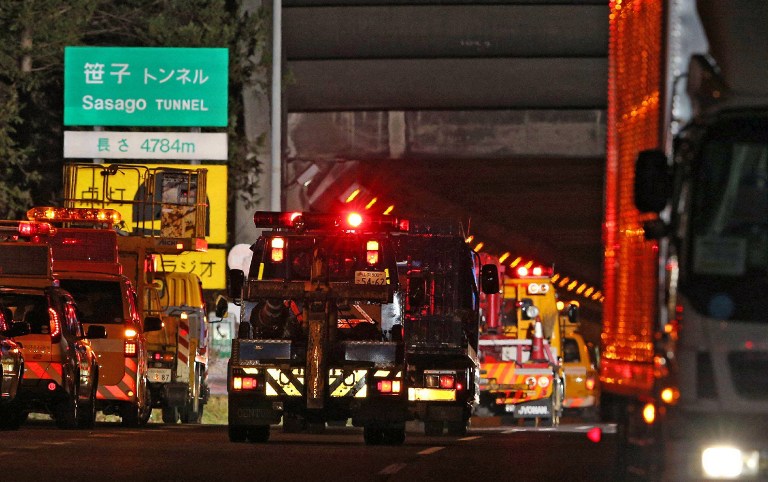SUMMARY
This is AI generated summarization, which may have errors. For context, always refer to the full article.

TOKYO, Japan (UPDATED) – Rescuers found three crushed bodies in a collapsed tunnel on a major Japanese highway, taking the death toll to nine Monday, December 3, as questions mounted about whether decaying ceiling supports caused the disaster.
At least three vehicles were buried on Sunday, December 2, when concrete ceiling panels crashed down inside the nearly five-kilometer (three-mile) tunnel, which passes through hills near Mount Fuji 80 kilometers (50 miles) west of Tokyo.
Witnesses spoke of terrifying scenes as at least one vehicle burst into flames inside one of Japan’s longest road tunnels, sending out clouds of blinding, acrid smoke.
Five blackened bodies were found inside a single vehicle and emergency workers also recovered the body of a truck driver, identified by broadcaster NHK as Tatsuya Nakagawa, 50, who had telephoned his company to ask for help.
Later, the bodies of an elderly man and two elderly women were also recovered from a crushed vehicle in the Sasago tunnel on the Chuo Expressway, Kyodo News said, as attention turned to what caused the collapse.
An official from highways operator NEXCO said material degradation was a possibility, adding the risk of further collapse remained although the ceiling had undergone its regular five-yearly inspection in September this year.
Chikaosa Tanimoto, professor emeritus of tunnel engineering at Osaka University, told that NHK the support panels were suspended from pillars.
“It is conceivable that the parts connecting the ceiling panels and pillars, or pillars themselves, have deteriorated, affected by vibrations from earthquakes and passing vehicles,” he said.
Earthquakes are common in Japan, though none was reported in the area at the time of the collapse.
Emergency workers equipped with breathing apparatus Sunday battled around a third of the way into the tunnel, where they found 110 meters (yards) of concrete panels had fallen, crushing several vehicles.
But hours later engineers warned the structure could be unstable, forcing rescuers to halt their work as a team of experts assessed the danger.
Dozens of people on Sunday abandoned their vehicles on the Tokyo-bound section of carriageway, and ran for the exits where they huddled in bitter winter weather.
One man who fled the tunnel told Jiji Press he had watched in horror as concrete crashed down onto a vehicle in front of him, leaving little more than a mound of dust and debris.
Voices cried out “Help” and “Anyone please help” from the pile before a young woman emerged with her clothes torn, he was reported as saying.
She could not stop trembling, he told the agency, as he asked her how many had been inside the vehicle.
“She said: ‘All of my friends and my boyfriend… Please help them,'” said the man, adding the flames were too strong.
Footage from security cameras showed large concrete panels had fallen, apparently having collapsed from the middle.
The tunnel sits on a major road connecting Tokyo with the centre and west of the country. Japan has an extensive web of highways with thousands of tunnels, usually several hundred meters long. Millions of cars use the network every day. – Hiroshi Hiyama, Agence France-Presse
Add a comment
How does this make you feel?
There are no comments yet. Add your comment to start the conversation.